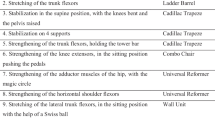Abstract
The aim of this study was to determine the effects of improvements in urinary incontinence resulting from pelvic floor rehabilitation on the sexual function of patients. The study involved 42 clinic patients who received pelvic floor rehabilitation treatment. Their sexual histories were obtained through face-to-face interviews. Pelvic muscle strength was measured with a perineometer. Improvement in incontinence was measured with the pad test. Seventeen women reported decreased sexual desire before the treatment; 5 of these indicated improvement after treatment. Nine of 17 women who experienced dyspareunia prior to treatment reported an improvement afterwards, and four women reported complete relief from pain. Five of 15 women who complained of difficulty in reaching climax before the treatment experienced improvement in this area. In conclusion, an improvement in sexual desire, performance during coitus and achievement of orgasm were observed in women who received pelvic floor muscle rehabilitation. No change was seen in the arousal and resolution stages of sexual activity.
Similar content being viewed by others
Abbreviations
- FES:
-
Functional electrical stimulation
References
Dolman M (1997) Continence issues. In: Andrews G, ed. Women's sexual health. London, Baillière Tindall, 365–389
Gordon D, Groutz A, Sinai T et al. (1999) Sexual function in women attending a urogynecology clinic. Int Urogynecol J 10:325–328
Moller LA, Lose G (2000) Sexuality and urinary incontinence: Cause or effect? Int Urogynecol J 11:58
Mouritsen L (1997) Sex and urogynecological problems − a survey. Nordisk Sexologi 15:89–98
Temml C, Haidinger G, Schmidbauer J et al. (2000) Urinary incontinence in both sexes: Prevalence rates and impact on quality of life and sexual life. Neurol Urodyn 19:259–271
Weber AM, Walters MD, Schover LR et al. (1995) Sexual function in women with uterovaginal prolapse and urinary incontinence. Obstet Gynecol 85:483–487
Winder A (1995) Sexuality and incontinence, professional issues. London, Association for Continence Advice
Fantl JA, Newman DK, Colling J et al. (1996) Urinary incontinence in adults: Acute and chronic management. Rockville MD, US Department of Health and Human Services
Hahn I, Milsom I, Fall M et al. (1993) Long-term results of pelvic floor training in female stress urinary incontinence. Br J Urol 72:421–427
Meyer S, Dhenin T, Schmidt N et al. (1992) Subjective and objective effects of intravaginal electrical myostimulation and biofeedback in patients with genuine stress urinary incontinence. Br J Urol 69:584–588
Sampselle CM, Dougherty MC, Newman DK et al. (1997) Continence for women: evidence-based practice. JOGNN 26:375–385
Bo K, Talselth T, Vinsnes J (2000) Randomized controlled trial on the effect of pelvic floor muscle training on quality of life and sexual problems in genuine stress incontinent women. Acta Obstet Gynecol Scand 79:598–603
Laycock J, Green PJ (1988) Interferential therapy in the treatment of incontinence. Physiotherapy 74:161–168
Brink CA, Wells TJ, Sampselle CM et al. (1994) A digital test for pelvic muscle strength in women with urinary incontinence. Nurs Res 43:352
Jabs C, Baessler K, Stanton SL (2000) Coital Incontinence among urogynecological patients. International Continence Society Annual Meeting 177
Weber AM, Walters MD, Schover LR, Mitchinson A. (1995)Vaginal anatomy and sexual function. Obstet Gynecol 86:946–949
Acknowledgment
This work was supported by the Research Fund of the University of Istanbul. Project number: B-572/17072000.
Author information
Authors and Affiliations
Corresponding author
Additional information
Editorial Comment: Previous studies suggest that the prevalence of sexual dysfunction is high amongst women with urinary incontinence. Some data exist about the effect of surgical treatment of urinary incontinence and its effect on sexual function. Data also exist that women with sexual dysfunction due to painful conditions improve with pelvic floor therapy. It could be expected that women with urinary incontinence and sexual dysfunction show better overall improvement of both conditions when treated with pelvic floor therapy rather than with surgery. Patients in this study showed improvement in urinary incontinence with pelvic floor therapy. They also had a marked decrease in dyspareunia. Overall, there was improvement in sexual function, particularly an increase in desire. Unfortunately, the study does not address whether this improvement appears to be related to a decrease in incontinence, a decrease in pain with intercourse or an additive effect.
Appendix
Appendix

Rights and permissions
About this article
Cite this article
Beji, N.K., Yalcin, O. & Erkan, H.A. The effect of pelvic floor training on sexual function of treated patients. Int Urogynecol J 14, 234–238 (2003). https://doi.org/10.1007/s00192-003-1071-2
Received:
Accepted:
Published:
Issue Date:
DOI: https://doi.org/10.1007/s00192-003-1071-2




